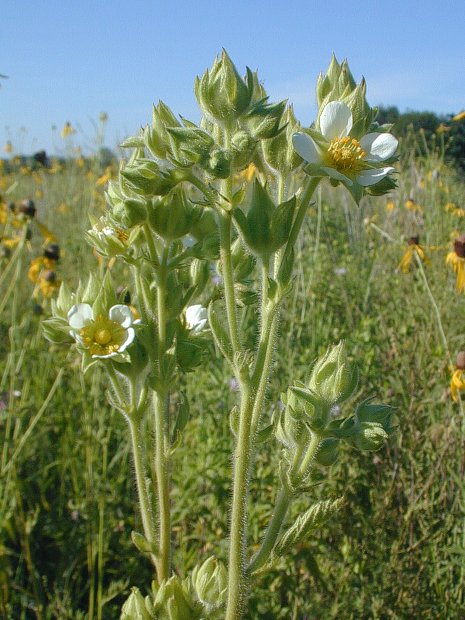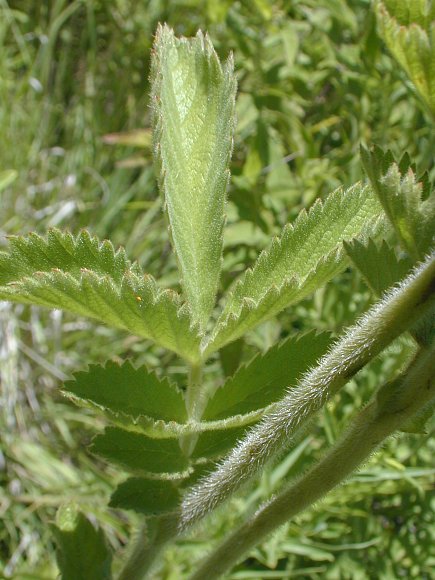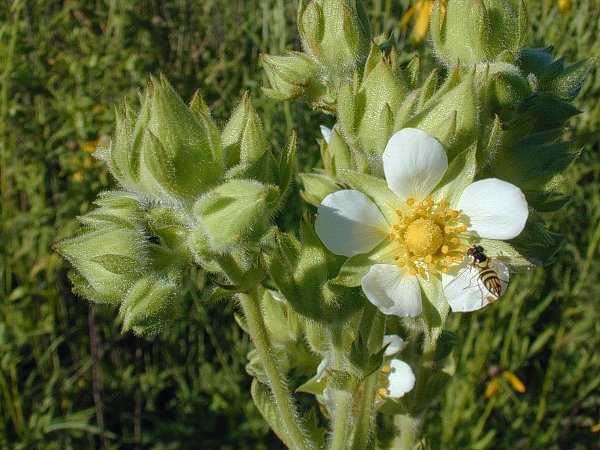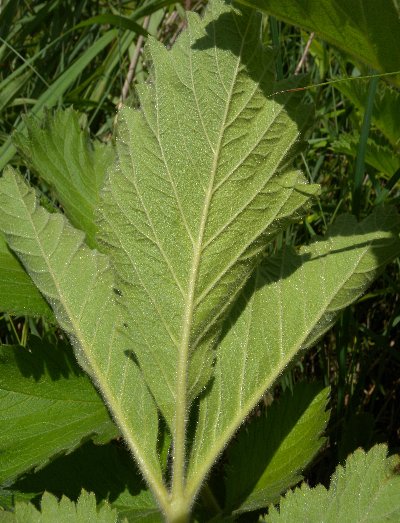Description: This perennial plant is unbranched, except slightly near the inflorescence, and up to 3' tall. The central stem is stout and covered with spreading white hairs. The pinnate compound leaves are also covered with white hairs, and consist of 3-11 leaflets. They are located primarily at the base of the plant, although a few small compound leaves alternate along the central stem above. Each leaflet is up to 3" long and 2" across, with the leaflets becoming larger toward the tip of the compound leaf (away from the stem). A leaflet is coarsely serrated along the margins, pinnately veined, and has an ovate or oblong shape (with blunt tips). The entire plant appears light or whitish green.

The inflorescence occurs as a tight cluster of the flowers at the apex of the plant, sometimes with smaller side clusters. A flower has 5 white petals, 5 light green sepals, 20 or more golden stamens, and a small golden reproductive structure in the center. It is about ¾" across and resembles the flower of a strawberry plant. There is no floral scent. The blooming period occurs during mid-summer and lasts about a month – only a few flowers are open at the same time. The small seeds are distributed to some extent by the wind. The root system consists of a central taproot, and there are rhizomes that help to spread the plant, although it is not particularly aggressive.

Cultivation:
The preference is full sun and mesic to dry conditions. This plant is
not particular about soil type, as long as the site is well-drained. In
native habitats, it's often found in soil that contains some clay,
rocky material, or sand.
Drought tolerance is excellent, and foliar disease is rarely observed.
This plant is easy to grow if the above requirements are met.
Range & Habitat:
The native Prairie Cinquefoil occurs occasionally in the northern half
of Illinois
(see Distribution
Map). Habitats include mesic to dry black soil prairies, clay
prairies, sand prairies, gravel prairies, hill prairies, Black Oak
savannas, and abandoned pastures. Unlike some of its weedy relatives,
this plant is normally found in high quality habitats, rather than
disturbed areas.

Faunal Associations: The nectar and pollen of the flowers attract small bees and flies, especially Halictid bees and Syrphid flies. The larvae of some small insects form galls or mine the leaves of cinquefoils (Potentilla spp.). These species include the Cinquefoil Stem Gall Midge (Neolasioptera potentillaecaulis), the Cinquefoil Axil Gall Wasp (Diastrophus potentillae) and other galls wasps, the sawfly Fenella nigrita, and the Douglas moth, Tinagma obscurofasciella (Felt, 1917; Smith, 2006; Microleps website, 2010). Other insect feeders include Acyrthosiphon spp. and other aphids, Northern Grasshopper (Melanoplus borealis), and Bruner's Grasshopper (Melanoplus bruneri); see Robinson & Bailey (1965), Blackman & Eastop (2013), and Brust et al. (2008). White-tailed Deer and probably other mammalian herbivores browse on the foliage of these plants occasionally – the seeds of cinquefoils often pass through their digestive tracts and remain viable. Thus, such mammalian herbivores help to spread these plants to new locations (Voigt Englund & Meyer, 1986; Myers et al., 2004). The seeds of cinquefoils are eaten in small amounts by the Deer Mouse and possibly other small rodents (Houtcooper, 1978).

Photographic
Location:
The photographs were taken at Meadowbrook Park in Urbana, Illinois, and
at a prairie of Parkland College
in Champaign, Illinois.
Comments:
This rather ordinary-looking plant resembles Potentilla recta
(Sulfur Cinquefoil), an introduced plant, in its erect habit and
overall appearance. However, Prairie Cinquefoil has white or cream
flowers and hairy pinnate leaves, while Sulfur Cinquefoil has light
yellow flowers and less hairy palmate leaves. An older scientific name
of Prairie Cinquefoil is Potentilla
arguta. When ultra-blue light is
made visible through a special filter, patterns are revealed in the
flowers of many cinquefoils (Potentilla
spp.) that are not apparent to the human eye, but
perceptible by most pollinating insects. These ultra-violet reflecting
patterns help the flowers stand out from the background, and may
function as nectar guides. Thus, the flowers are colored a combination
of either white or yellow with bee-blue.